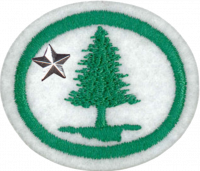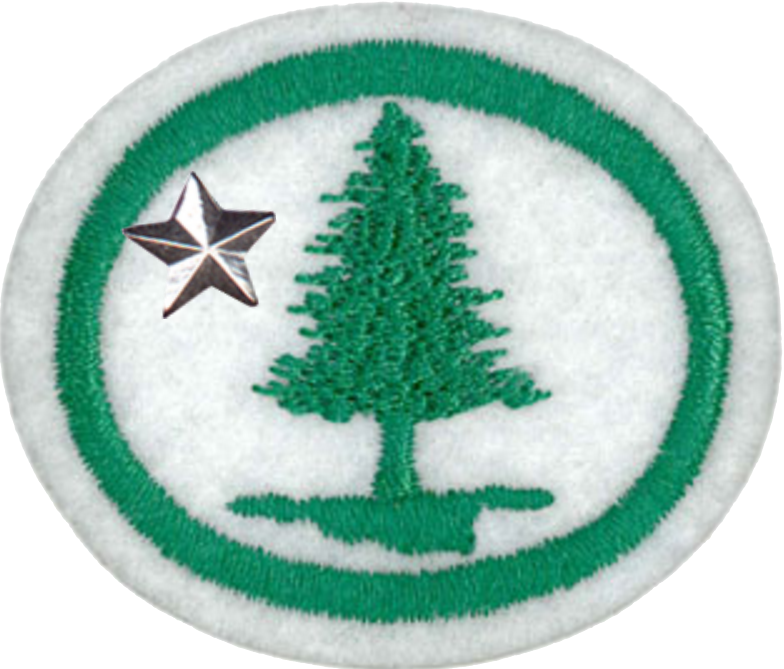Difference between revisions of "AY Honors/Trees - Advanced/Requirements"
From Pathfinder Wiki
< AY Honors | Trees - AdvancedAY Honors/Trees - Advanced/Requirements
m (Importing a new version from external source) |
m (- Category of Honor Requirements) |
||
| (13 intermediate revisions by 2 users not shown) | |||
| Line 1: | Line 1: | ||
| − | + | {{HonorSubpage}} | |
| − | |||
| − | {{ | ||
| − | == | + | <section begin=Body /> |
| − | + | ||
| − | + | <b>1. <section begin=req1 /><noinclude><translate><!--T:1--> | |
| − | + | </noinclude>Have the Trees honor. | |
| − | + | <noinclude></translate></noinclude><section end=req1 /></b> | |
| − | + | ||
| − | <noinclude></translate></noinclude> | + | <b>2. <section begin=req2 /><noinclude><translate><!--T:2--> |
| + | </noinclude>Collect, identify, press, and mount leaves of 35 different species of trees. | ||
| + | <noinclude></translate></noinclude><section end=req2 /></b> | ||
| + | |||
| + | <b>3. <section begin=req3 /><noinclude><translate><!--T:3--> | ||
| + | </noinclude>Separately collect, press, mount, and label specimens that demonstrate the following terms: | ||
| + | <noinclude></translate></noinclude><section end=req3 /></b> | ||
| + | |||
| + | :<b>a. <section begin=req3a /><noinclude><translate><!--T:4--> | ||
| + | </noinclude>Serrate | ||
| + | <noinclude></translate></noinclude><section end=req3a /></b> | ||
| + | |||
| + | :<b>b. <section begin=req3b /><noinclude><translate><!--T:5--> | ||
| + | </noinclude>Doubly serrate | ||
| + | <noinclude></translate></noinclude><section end=req3b /></b> | ||
| + | |||
| + | :<b>c. <section begin=req3c /><noinclude><translate><!--T:6--> | ||
| + | </noinclude>Entire | ||
| + | <noinclude></translate></noinclude><section end=req3c /></b> | ||
| + | |||
| + | :<b>d. <section begin=req3d /><noinclude><translate><!--T:7--> | ||
| + | </noinclude>Crenate | ||
| + | <noinclude></translate></noinclude><section end=req3d /></b> | ||
| + | |||
| + | :<b>e. <section begin=req3e /><noinclude><translate><!--T:8--> | ||
| + | </noinclude>Dentate | ||
| + | <noinclude></translate></noinclude><section end=req3e /></b> | ||
| + | |||
| + | :<b>f. <section begin=req3f /><noinclude><translate><!--T:9--> | ||
| + | </noinclude>Lobe | ||
| + | <noinclude></translate></noinclude><section end=req3f /></b> | ||
| + | |||
| + | :<b>g. <section begin=req3g /><noinclude><translate><!--T:10--> | ||
| + | </noinclude>Incise | ||
| + | <noinclude></translate></noinclude><section end=req3g /></b> | ||
| + | |||
| + | :<b>h. <section begin=req3h /><noinclude><translate><!--T:11--> | ||
| + | </noinclude>Whorled | ||
| + | <noinclude></translate></noinclude><section end=req3h /></b> | ||
| + | |||
| + | :<b>i. <section begin=req3i /><noinclude><translate><!--T:12--> | ||
| + | </noinclude>Opposite | ||
| + | <noinclude></translate></noinclude><section end=req3i /></b> | ||
| + | |||
| + | :<b>j. <section begin=req3j /><noinclude><translate><!--T:13--> | ||
| + | </noinclude>Alternate | ||
| + | <noinclude></translate></noinclude><section end=req3j /></b> | ||
| + | |||
| + | :<b>k. <section begin=req3k /><noinclude><translate><!--T:14--> | ||
| + | </noinclude>Pinnately compound | ||
| + | <noinclude></translate></noinclude><section end=req3k /></b> | ||
| + | |||
| + | :<b>l. <section begin=req3l /><noinclude><translate><!--T:15--> | ||
| + | </noinclude>Triple compound (if possible) | ||
| + | <noinclude></translate></noinclude><section end=req3l /></b> | ||
| + | |||
| + | <b>4. <section begin=req4 /><noinclude><translate><!--T:16--> | ||
| + | </noinclude>Complete the following: | ||
| + | <noinclude></translate></noinclude><section end=req4 /></b> | ||
| + | |||
| + | :<b>a. <section begin=req4a /><noinclude><translate><!--T:44--> | ||
| + | </noinclude>Describe the advantages in using the Latin or scientific names. | ||
| + | <noinclude></translate></noinclude><section end=req4a /></b> | ||
| + | |||
| + | :<b>b. <section begin=req4a /><noinclude><translate><!--T:45--> | ||
| + | </noinclude>Of what use are the two parts of a scientific name? | ||
| + | <noinclude></translate></noinclude><section end=req4a /></b> | ||
| + | |||
| + | <b>5. <section begin=req5 /><noinclude><translate><!--T:17--> | ||
| + | </noinclude>Name six families of trees in the angiosperm class and three families in the gymnosperm class. | ||
| + | <noinclude></translate></noinclude><section end=req5 /></b> | ||
| + | |||
| + | <b>6. <section begin=req6 /><noinclude><translate><!--T:18--> | ||
| + | </noinclude>Know and describe the function of leaves in the life of a tree. | ||
| + | <noinclude></translate></noinclude><section end=req6 /></b> | ||
| + | |||
| + | <b>7. <section begin=req7 /><noinclude><translate><!--T:19--> | ||
| + | </noinclude>Name the families of trees in your area which have opposite leaves. | ||
| + | <noinclude></translate></noinclude><section end=req7 /></b> | ||
| + | |||
| + | <b>8. <section begin=req8 /><noinclude><translate><!--T:20--> | ||
| + | </noinclude>Define the following terms: | ||
| + | <noinclude></translate></noinclude><section end=req8 /></b> | ||
| + | |||
| + | :<b>a. <section begin=req8a /><noinclude><translate><!--T:21--> | ||
| + | </noinclude>Stipule | ||
| + | <noinclude></translate></noinclude><section end=req8a /></b> | ||
| + | |||
| + | :<b>b. <section begin=req8b /><noinclude><translate><!--T:22--> | ||
| + | </noinclude>Petiole | ||
| + | <noinclude></translate></noinclude><section end=req8b /></b> | ||
| + | |||
| + | :<b>c. <section begin=req8c /><noinclude><translate><!--T:23--> | ||
| + | </noinclude>Blade | ||
| + | <noinclude></translate></noinclude><section end=req8c /></b> | ||
| + | |||
| + | :<b>d. <section begin=req8d /><noinclude><translate><!--T:24--> | ||
| + | </noinclude>Pitch | ||
| + | <noinclude></translate></noinclude><section end=req8d /></b> | ||
| + | |||
| + | :<b>e. <section begin=req8e /><noinclude><translate><!--T:25--> | ||
| + | </noinclude>Heartwood | ||
| + | <noinclude></translate></noinclude><section end=req8e /></b> | ||
| + | |||
| + | :<b>f. <section begin=req8f /><noinclude><translate><!--T:26--> | ||
| + | </noinclude>Sapwood | ||
| + | <noinclude></translate></noinclude><section end=req8f /></b> | ||
| + | |||
| + | :<b>g. <section begin=req8g /><noinclude><translate><!--T:27--> | ||
| + | </noinclude>Springwood | ||
| + | <noinclude></translate></noinclude><section end=req8g /></b> | ||
| + | |||
| + | :<b>h. <section begin=req8h /><noinclude><translate><!--T:28--> | ||
| + | </noinclude>Summerwood | ||
| + | <noinclude></translate></noinclude><section end=req8h /></b> | ||
| + | |||
| + | :<b>i. <section begin=req8i /><noinclude><translate><!--T:29--> | ||
| + | </noinclude>Annual ring | ||
| + | <noinclude></translate></noinclude><section end=req8i /></b> | ||
| + | |||
| + | :<b>j. <section begin=req8j /><noinclude><translate><!--T:30--> | ||
| + | </noinclude>Cambium | ||
| + | <noinclude></translate></noinclude><section end=req8j /></b> | ||
| + | |||
| + | :<b>k. <section begin=req8k /><noinclude><translate><!--T:31--> | ||
| + | </noinclude>Xylem | ||
| + | <noinclude></translate></noinclude><section end=req8k /></b> | ||
| + | |||
| + | :<b>l. <section begin=req8l /><noinclude><translate><!--T:32--> | ||
| + | </noinclude>Phloem | ||
| + | <noinclude></translate></noinclude><section end=req8l /></b> | ||
| + | |||
| + | <b>9. <section begin=req9 /><noinclude><translate><!--T:33--> | ||
| + | </noinclude>What families of trees have: | ||
| + | <noinclude></translate></noinclude><section end=req9 /></b> | ||
| + | |||
| + | :<b>a. <section begin=req9a /><noinclude><translate><!--T:34--> | ||
| + | </noinclude>Thorns | ||
| + | <noinclude></translate></noinclude><section end=req9a /></b> | ||
| + | |||
| + | :<b>b. <section begin=req9b /><noinclude><translate><!--T:35--> | ||
| + | </noinclude>Catkins | ||
| + | <noinclude></translate></noinclude><section end=req9b /></b> | ||
| + | |||
| + | :<b>c. <section begin=req9c /><noinclude><translate><!--T:36--> | ||
| + | </noinclude>Winged seeds | ||
| + | <noinclude></translate></noinclude><section end=req9c /></b> | ||
| + | |||
| + | :<b>d. <section begin=req9d /><noinclude><translate><!--T:37--> | ||
| + | </noinclude>Acorns | ||
| + | <noinclude></translate></noinclude><section end=req9d /></b> | ||
| + | |||
| + | :<b>e. <section begin=req9e /><noinclude><translate><!--T:38--> | ||
| + | </noinclude>Pods | ||
| + | <noinclude></translate></noinclude><section end=req9e /></b> | ||
| + | |||
| + | :<b>f. <section begin=req9f /><noinclude><translate><!--T:39--> | ||
| + | </noinclude>Capsules | ||
| + | <noinclude></translate></noinclude><section end=req9f /></b> | ||
| + | |||
| + | :<b>g. <section begin=req9g /><noinclude><translate><!--T:40--> | ||
| + | </noinclude>Nuts | ||
| + | <noinclude></translate></noinclude><section end=req9g /></b> | ||
| + | |||
| + | :<b>h. <section begin=req9h /><noinclude><translate><!--T:41--> | ||
| + | </noinclude>Berries | ||
| + | <noinclude></translate></noinclude><section end=req9h /></b> | ||
| + | |||
| + | <section begin=challenge /> | ||
| + | <b>10. <section begin=req10 /><noinclude><translate><!--T:42--> | ||
| + | </noinclude>Identify ten deciduous trees by their “winter” characteristics, (features other than leaves) such as twig and bud, characteristic form, and growth habits. | ||
| + | <noinclude></translate></noinclude><section end=req10 /></b> | ||
| + | <section end=challenge /> | ||
| + | <section end=Body /> | ||
Latest revision as of 20:18, 21 July 2022
1. Have the Trees honor.
2. Collect, identify, press, and mount leaves of 35 different species of trees.
3. Separately collect, press, mount, and label specimens that demonstrate the following terms:
- a. Serrate
- b. Doubly serrate
- c. Entire
- d. Crenate
- e. Dentate
- f. Lobe
- g. Incise
- h. Whorled
- i. Opposite
- j. Alternate
- k. Pinnately compound
- l. Triple compound (if possible)
4. Complete the following:
- a. Describe the advantages in using the Latin or scientific names.
- b. Of what use are the two parts of a scientific name?
5. Name six families of trees in the angiosperm class and three families in the gymnosperm class.
6. Know and describe the function of leaves in the life of a tree.
7. Name the families of trees in your area which have opposite leaves.
8. Define the following terms:
- a. Stipule
- b. Petiole
- c. Blade
- d. Pitch
- e. Heartwood
- f. Sapwood
- g. Springwood
- h. Summerwood
- i. Annual ring
- j. Cambium
- k. Xylem
- l. Phloem
9. What families of trees have:
- a. Thorns
- b. Catkins
- c. Winged seeds
- d. Acorns
- e. Pods
- f. Capsules
- g. Nuts
- h. Berries
10. Identify ten deciduous trees by their “winter” characteristics, (features other than leaves) such as twig and bud, characteristic form, and growth habits.


